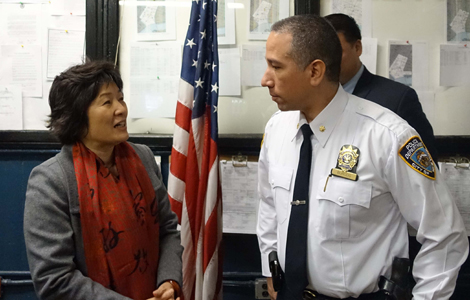WWIII hoax reminds: There's no room for miscommunication
Updated: 2015-01-19 11:44
By Chen Weihua(China Daily USA)
|
||||||||
World War I resulted in the deaths of 9 million combatants and 7 million civilians. World War II caused an estimated 50 million to 85 million fatalities. A World War III, with all the 21st century's lethal weapons, is fated to be far more catastrophic.
So when the Twitter accounts of United Press International (UPI) and the New York Post tweeted on Jan 16 that a war had broken out between China and the United States, it should send more than just a chilling message to anyone who read it.
One UPI message said: "BREAKING: Chinese anti-ship missile fired at USS George Washington. Another: "US Joint Chiefs of Staff: USS George Washington damaged, US Navy now engaged in active combat against Chinese vessels in South China Sea."
Soon enough people realized it was a false alarm, that both accounts had been hacked that day.
The US Navy confirmed on Jan 16 that the US aircraft carrier George Washington had not been attacked and WWIII had not begun. The carrier was in port and not even in the South China Sea.
Pentagon spokesman Rear Admiral John Kirby on Jan 16 afternoon also said in a press briefing that "I can assure you and everybody else that the George Washington is safe and sound in a dry dock getting some needed maintenance done. She has not been attacked by anybody."
Kirby cautioned people about the bad information out there and its possible repercussions.
"That's why, you know, we check and double check and triple check," he said. "There's no overriding concern here about a false tweet leading to some kind of armed conflict, no."
Kirby said the US has avenues of communications with the Chinese leadership, such a direct communication between Chairman of the Joint Chiefs of Staff Martin Dempsey and his counterpart in Beijing and other avenues in other government agencies, in particular the State Department, but he said it's not yet a hotline.
While praising social media as a good platform to share information, Kirby said, "it's also, regrettably, a platform for foolish people to do foolish things".
"We're not going to overreact," he said. "We have ways of checking and rechecking."
The Pentagon website has posted a new guide aimed at helping managers keep social media accounts safe.
While the hoax on Friday has neither triggered a war or even a stock market fluctuation, it may remind China and the US of the importance of close communication between the two militaries to prevent potential miscalculation and misjudgment.
The two countries have pledged to make progress in that regard. During US President Barack Obama's trip to Beijing in November, he and Chinese President Xi Jinping endorsed two memoranda of understanding for the two militaries to work together to reduce the possibility of military accidents by early notification of major military operations and establishing guidelines of behavior on naval and air military encounters.
That appears to be an increasingly urgent task as the US plans to send its most sophisticated ships and aircraft to the Asia-Pacific region to beef up its presence in the region under the so-called Pivot to Asia-Pacific strategy. Under the plan, roughly 60 percent of the US Navy fleet will be deployed in the Pacific by 2020.
That occurs at a time when a fast-growing China is modernizing its defense capabilities, including building a powerful navy and air force and stepping up its presence in the region.
The situation has been complicated by the fact that the US military has long been operating close-in surveillance along China's coast, and the maritime territorial disputes in the South and East China seas between China and the Philippines and Japan - two US security treaty allies - could potentially involve the US.
Despite the growing military-to-military exchanges between China and the US in the past two years, distrust or a lack of mutual trust, mutual understanding or communication is still a key issue between the two militaries.
There are bitter lessons from the US EP-3 spy plane collision with a Chinese fighter jet in 2001 and the near collision in late 2013 of US Navy guided missile cruiser Cowpens and a Chinese fleet, both in South China Sea.

Some pointed out that the US and Soviet Union maintained a hotline through the height of the Cold War, but such a hotline does not exist between China and the US, despite the some 90 bilateral mechanisms covering a wide range of fields.
Of course, things are improving as shown by the two MOUs regarding the military during Obama's trip to Beijing.
From Jan 12-19, the two militaries have been engaging in a dialogue and joint drills on humanitarian assistance and disaster relief in southern China's Guangdong province and Hainan Island, with 150 engineering and medical service personnel from the two countries taking part.
But the 2000 US National Defense Authorization Act forbids the US military from conducting more exchanges and joint drills with its Chinese counterpart, something the Chinese have regarded as a major hindrance to improving military-to-military ties.
The Twitter hoax last Friday might be a timely warning to leave no room for misunderstanding, miscalculation and misjudgment.
Contact the writer at chenweihua@chinadailyusa.com.

 Music at her fingers
Music at her fingers
 Across America Over the Week (Jan 16 - Jan 22)
Across America Over the Week (Jan 16 - Jan 22)
 Spend Chinese New Year in style
Spend Chinese New Year in style
 Ili river valley becomes a popular destination for swans
Ili river valley becomes a popular destination for swans
 Philip Ma: from scientist to businessman
Philip Ma: from scientist to businessman
 Birmingham's Spotlight on China dinner
Birmingham's Spotlight on China dinner
 How to distinguish doucai, wucai, Famille-rose and enamel porcelain
How to distinguish doucai, wucai, Famille-rose and enamel porcelain
 Xinjiang lake in bumper fishing season
Xinjiang lake in bumper fishing season
Most Viewed
Editor's Picks

|

|

|

|

|

|
Today's Top News
Houston's SW Chinatown
China to focus on reforms, opening of capital market
Slowdown brings new risks to banks
Trade group calls for BIT
Market status for China is 'political' issue
Birmingham's Spotlight on China dinner
Bank takes renminbi-clearing seriously
Traditional Garb
US Weekly

|

|








